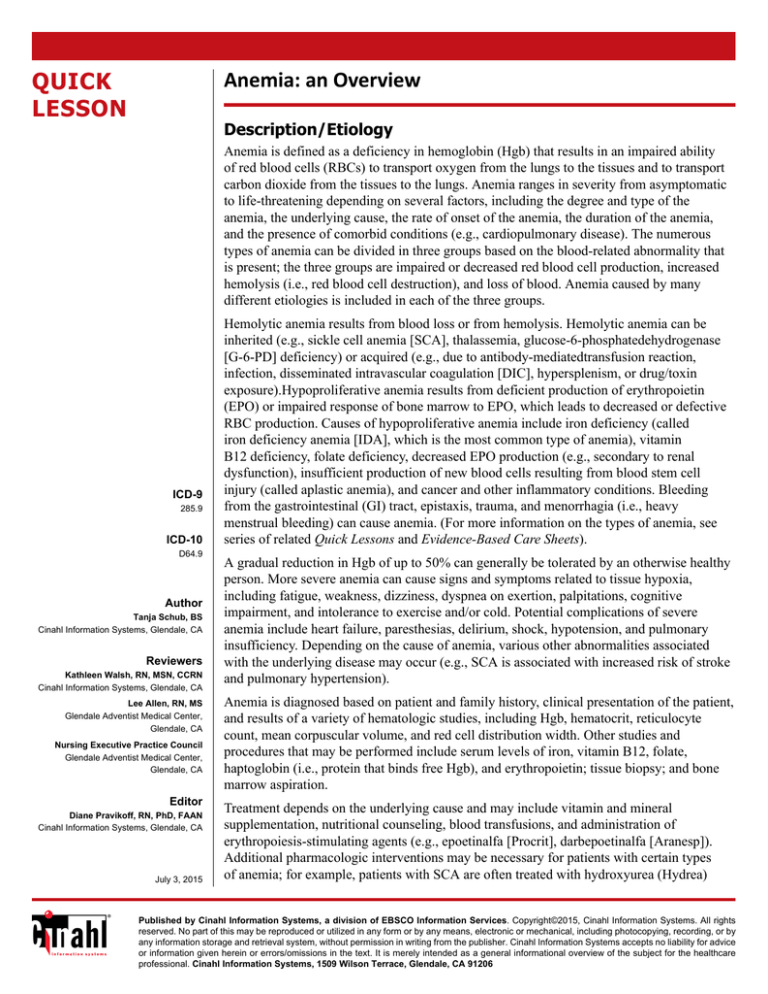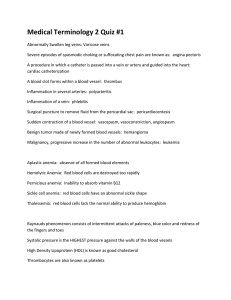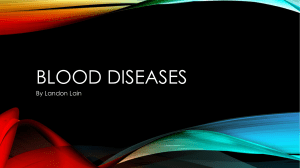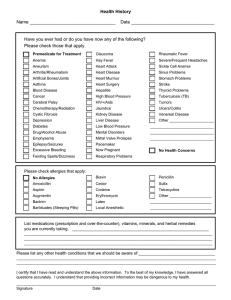
QUICK
LESSON
Anemia: an Overview
Description/Etiology
Anemia is defined as a deficiency in hemoglobin (Hgb) that results in an impaired ability
of red blood cells (RBCs) to transport oxygen from the lungs to the tissues and to transport
carbon dioxide from the tissues to the lungs. Anemia ranges in severity from asymptomatic
to life-threatening depending on several factors, including the degree and type of the
anemia, the underlying cause, the rate of onset of the anemia, the duration of the anemia,
and the presence of comorbid conditions (e.g., cardiopulmonary disease). The numerous
types of anemia can be divided in three groups based on the blood-related abnormality that
is present; the three groups are impaired or decreased red blood cell production, increased
hemolysis (i.e., red blood cell destruction), and loss of blood. Anemia caused by many
different etiologies is included in each of the three groups.
ICD-9
285.9
ICD-10
D64.9
Author
Tanja Schub, BS
Cinahl Information Systems, Glendale, CA
Reviewers
Kathleen Walsh, RN, MSN, CCRN
Cinahl Information Systems, Glendale, CA
Lee Allen, RN, MS
Glendale Adventist Medical Center,
Glendale, CA
Nursing Executive Practice Council
Glendale Adventist Medical Center,
Glendale, CA
Editor
Diane Pravikoff, RN, PhD, FAAN
Cinahl Information Systems, Glendale, CA
July 3, 2015
Hemolytic anemia results from blood loss or from hemolysis. Hemolytic anemia can be
inherited (e.g., sickle cell anemia [SCA], thalassemia, glucose-6-phosphatedehydrogenase
[G-6-PD] deficiency) or acquired (e.g., due to antibody-mediatedtransfusion reaction,
infection, disseminated intravascular coagulation [DIC], hypersplenism, or drug/toxin
exposure).Hypoproliferative anemia results from deficient production of erythropoietin
(EPO) or impaired response of bone marrow to EPO, which leads to decreased or defective
RBC production. Causes of hypoproliferative anemia include iron deficiency (called
iron deficiency anemia [IDA], which is the most common type of anemia), vitamin
B12 deficiency, folate deficiency, decreased EPO production (e.g., secondary to renal
dysfunction), insufficient production of new blood cells resulting from blood stem cell
injury (called aplastic anemia), and cancer and other inflammatory conditions. Bleeding
from the gastrointestinal (GI) tract, epistaxis, trauma, and menorrhagia (i.e., heavy
menstrual bleeding) can cause anemia. (For more information on the types of anemia, see
series of related Quick Lessons and Evidence-Based Care Sheets).
A gradual reduction in Hgb of up to 50% can generally be tolerated by an otherwise healthy
person. More severe anemia can cause signs and symptoms related to tissue hypoxia,
including fatigue, weakness, dizziness, dyspnea on exertion, palpitations, cognitive
impairment, and intolerance to exercise and/or cold. Potential complications of severe
anemia include heart failure, paresthesias, delirium, shock, hypotension, and pulmonary
insufficiency. Depending on the cause of anemia, various other abnormalities associated
with the underlying disease may occur (e.g., SCA is associated with increased risk of stroke
and pulmonary hypertension).
Anemia is diagnosed based on patient and family history, clinical presentation of the patient,
and results of a variety of hematologic studies, including Hgb, hematocrit, reticulocyte
count, mean corpuscular volume, and red cell distribution width. Other studies and
procedures that may be performed include serum levels of iron, vitamin B12, folate,
haptoglobin (i.e., protein that binds free Hgb), and erythropoietin; tissue biopsy; and bone
marrow aspiration.
Treatment depends on the underlying cause and may include vitamin and mineral
supplementation, nutritional counseling, blood transfusions, and administration of
erythropoiesis-stimulating agents (e.g., epoetinalfa [Procrit], darbepoetinalfa [Aranesp]).
Additional pharmacologic interventions may be necessary for patients with certain types
of anemia; for example, patients with SCA are often treated with hydroxyurea (Hydrea)
Published by Cinahl Information Systems, a division of EBSCO Information Services. Copyright©2015, Cinahl Information Systems. All rights
reserved. No part of this may be reproduced or utilized in any form or by any means, electronic or mechanical, including photocopying, recording, or by
any information storage and retrieval system, without permission in writing from the publisher. Cinahl Information Systems accepts no liability for advice
or information given herein or errors/omissions in the text. It is merely intended as a general informational overview of the subject for the healthcare
professional. Cinahl Information Systems, 1509 Wilson Terrace, Glendale, CA 91206
chemotherapy to reduce the frequency of severe pain crises and acute chest syndrome, and patients with aplastic anemia are
commonly treated with immunosuppressive therapy. Bone marrow transplantation may be curative in patients with SCA,
thalassemia, or aplastic anemia.
Facts and Figures
The World Health Organization defines anemia as having a Hgb value of < 12.5 g/dL in adults, < 12 g/dL in children who are
6–14 years of age, and < 11 g/dL in children who are 5 months to 6 years of age. Approximately 65% of iron in the body is
found in Hgb that is in circulating RBCs. Anemia affects one-quarter of the world population, and has a higher prevalence
in preschool-aged children (48%) and pregnant women (42%). The prevalence of anemia is 2–5 times higher in developing
countries than in the United States. Using the higher limits of 13.5 g/dL for men and 12.5 g/dL for women, which are the
values commonly used to define anemia in the U.S., ~ 4% of men and 8% of women in the U.S. have anemia.
Risk Factors
Risk factors for anemia include family history of anemia (e.g., in cases of SCA, thalassemia, or G-6-PD deficiency), medical
conditions associated with chronic blood loss (e.g., hookworm infection, peptic ulcer disease, inflammatory bowel disease,
gastric or colon carcinoma, liver disease, or chronic use of nonsteroidal anti-inflammatory drugs [NSAIDs] or aspirin), poverty,
frequent blood donation, pregnancy, kidney disease, trauma, burns, frostbite, certain dietary factors (e.g., strict vegetarian or
vegan diet unless supplemented with iron and vitamin B12). Certain types of anemia are more common in men (e.g., X-linked
anemia such as that caused by G-6-PD deficiency), and other types are more common in women (e.g., IDA due to blood loss
during menses and increased iron demands in pregnancy). SCA primarily affects persons of African, Mediterranean, Middle
Eastern, and Asian Indian ancestry. Thalassemia is most common in persons from tropical and subtropical regions of Asia, the
Mediterranean, and the Middle East.
Signs and Symptoms/Clinical Presentation
› For information regarding clinical presentation, see Description/Etiology, above, and the series of related Quick Lessons and
Evidence-Based Care Sheets
Assessment
› Patient History
• Obtain a complete medical history, including history of signs and symptoms, history of anemia, and possible sources of
blood loss; ask about dietary intake, use of medications and supplements, and family history of anemia
› Laboratory Tests That May Be Ordered
• Laboratory tests that may be performed in the diagnosis and classification of anemia include CBC, levels of Hgb and
Hct, cytology, iron studies, serum vitamin B12 and folate levels, erythropoietin levels, certain genetic tests, and Hgb
electrophoresis
• Histologic examination of biopsied bone marrow samples may be performed to assess for the cause of hypoproliferative
anemia
› Other Diagnostic Tests/Studies
• Colonoscopy and upper endoscopy may be performed to assess for GI sources of bleeding
Treatment Goals
› Promote Resolution of Anemia and Optimum Physiologic Function
• Monitor vital signs, access all physiologic systems, and frequently review laboratory/other diagnostic test results;
immediately report abnormalities and treat, as ordered
• Administer prescribed medications, as ordered; monitor treatment efficacy and for adverse effects; medications that may be
prescribed include
–supplements (e.g., ferrous sulfate, vitamin B12, folate)
–erythropoiesis-stimulating agents (e.g., epoetin, darbepoetin) to stimulate the bone marrow to produce RBCs
–analgesics (e.g., for pain associated with SCA)
–antibiotics for prophylaxis and treatment of bacterial infection in patients with anemia associated with increased risk of
infection, including SCA, thalassemia, and aplastic anemia
–hydroxyurea in patients with SCA
• Administer prescribed iron therapy (e.g., oral supplements or injections), as ordered
–Monitor iron levels in patients who are receiving iron therapy to avoid iron toxicity; administer iron chelation therapy, if
ordered
• Follow facility pre- and postsurgical protocols if the patient becomes a candidate for surgery (e.g., for bone marrow
transplantation or for splenectomy in patients with severe hemolytic anemia); reinforce pre- and postsurgical education and
verify completion of facility informed consent documents
• Promote optimal nutrition and request referral to a registered dietitian for patient evaluation and education regarding the
prescribed diet, as appropriate
› Provide Emotional Support and Educate
• Assess patient/family anxiety level and for knowledge deficits regarding anemia and its treatment; provide emotional
support, educate, and encourage discussion about the diagnosis, potential complications, treatment risks and benefits, and
individualized prognosis
Food for Thought
› SCA and thalassemia are autosomal recessive inherited disorders that are characterized by abnormal Hgb synthesis in
homozygotes (i.e., individuals who inherit two defective genes); heterozygotes (i.e., carriers of one defective gene)are
unaffected or have only minor disease manifestations, and are relatively protected from developing malaria. (For more
information, see Evidence-Based Care Sheet … Hemoglobinopathies: Resistance to Malaria )
› Anemia develops in ~ 60% of patients with solid tumors who are treated with chemotherapy; among patients with cancer, the
incidence of anemia is increased in those with lung cancer (71%) and gynecologic cancers (65%) because these cancers are
treated with platinum-based chemotherapy
• Researchers in a study of 591 adult patients with chemotherapy-induced anemia observed that treatment with EPO was
associated with increased Hgb levels and decreased psychological distress (Del Prete et al., 2014)
› Vitamin D deficiency, which is increasingly linked to a wide range of health conditions, may be a risk factor for anemia.
Investigators who analyzed data from 10,410 children and adolescents from the 2001–2006 National Health and Nutrition
Examination Survey found that lower vitamin D levels were associated with increased risk of anemia (Atkinson et al., 2014)
Red Flags
› Anemia with a Hgb of < 6 g/dL is considered life-threatening
› Potential complications of parenteral iron include anaphylaxis, muscle necrosis, and phlebitis
› EPO-stimulating agents have been associated with increased risk of death and severe cardiovascular events, and should be
prescribed at the lowest dose possible
What Do I Need to Tell the Patient/Patient’s Family?
› Emphasize the importance of strict adherence to the prescribed treatment regimen and continued medical surveillance for
patient monitoring
References
1. Atkinson, M.A., Melamed, M.L., Kumar, J., Roy, C.N., Miller, E.R., Furth, S.L., & Fadrowski, J.J. (2014). Vitamin D, race, and risk of anemia in children. Journal of Pediatrics,
153.e1-158.e1. doi:10.1016/j.peds.2013.08.060
2. Del Prete, S., Cinieri, S., Lorusso, V., Maiorino, L., Pizza, C., Pisano, A., ... Addeo, R. (2014). Impact of anemia management with EPO on psychologic distress in cancer
patients: Results of a multicenter patient survey. Future Oncology, 10(1), 69-78. doi:10.2217/fon.13.161
3. Herbinger, K.-H., Metzner, M., Schmidt, V., Beissner, M., Nothdurft, H.D., von Sonnenburg, F., & Löscher, T. (2013). Infection-induced anaemia: A cross-sectional study of
14,636 German travelers aged 20–49 years. Infection, 41(6), 1079-1087. doi:10.1007/s15010-013-0528-6
4. Maakaron, J. E., Taher, A., & Conrad, M. E. (2014, October 29). Anemia. Medscape Web site. Retrieved February 19, 2015, from
http://emedicine.medscape.com/article/198475-overview
5. National Institute for Health and Care Excellence. (2014). Erythropoiesis-stimulating agents (epoetin and darbepoetin) for treating anaemia in
people with cancer having chemotherapy (including review of TA142). NICE technology appraisal guidance 323. Retrieved February 19, 2015, from
http://www.nice.org.uk/guidance/ta323/resources/guidance-erythropoiesisstimulating-agents-epoetin-and-darbepoetin-for-treating-anaemia-in-people-with-cancer-having-chemotherapy-i
6. Naqvi, B.H., & Ferri, F.F. (2015). Anemia, iron deficiency. In 2015 Ferri’s clinical advisor: 5 books in 1 (pp. 94-95). Philadelphia, PA: Elsevier Mosby.
7. Understanding anemia—The basics. (2015). WebMD Medical Reference. Retrieved May 19, 2015, from http://www.webmd.com/a-to-z-guides/understanding-anemia-basics




